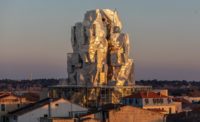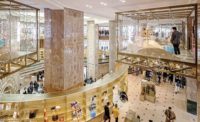“I think that at this point the idea of not having a face is very appealing,” said Rem Koolhaas, to general laughter, at a pre-opening event last month at OMA’s very discreet new Lafayette Anticipations building in Paris. “And not for any particular reason, but there’s an overdose of faces, and even for polemical reasons I think it’s really exciting to supposedly disappear.” Indeed were you not paying attention you might very well walk past this new arts center (cost undisclosed) in the city’s historic Marais district without even noticing it. Brainchild of the Fondation d’entreprise Galeries Lafayette—the cultural arm of the Galeries Lafayette retail group which, since its 1991 buyout of competitor store Bazar de l’Hôtel de Ville (BHV), owns numerous properties in what has been a secteur sauvegardé (protected historic area) since 1964—the new institution occupies a former BHV warehouse from 1891. Because of the building’s small footprint, the architects initially intended to demolish and rebuild the parts of the structure not visible from the street to create essential extra space, but a change in planning regulations two years into the project forced them to think again. Where, before 2014, only pre-1800 buildings were protected in the Marais secteur sauvegardé, now 19th-century structures are covered too. This meant negotiating with the Architectes des Bâtiments de France (ABF, the governmental body that oversees building conservation) about what could be done with the courtyard. The ingenious solution dreamt up by OMA is a steel-and-glass tower—structurally separate from the courtyard’s ashlar façades but entirely filling its void—equipped with motorized floors on a rack-and-pinion system which, when aligned with the building’s original floors, provide 3,200 square feet of extra space. A total of 49 floor configurations are possible (not all of them terribly useful), including bringing them all down to grade so that the courtyard can be enjoyed in something like its original state. Negotiations between OMA and the ABF were so cordial that the latter even sanctioned rule-breaking where the tower’s height was concerned, allowing it to terminate in a glass box that has been dubbed the “Ciel” (sky).
If this sounds like the architectural equivalent of Jean Tinguely, that’s not at all the intention, since visitors are never meant to see the floors moving. Rather the building is conceived as a lean, austere, no-frills art machine, where new works will be commissioned, made (there’s a whole great workshop in the basement) and displayed (in 9,000 square feet of gallery space). The foundation is keen to spin this as a renewal with the Marais’s history, the formerly aristocratic neighborhood having been transformed in the 19th century into a district of light industry and artisans, a place of production. But what nobody mentioned at the pre-opening event was that Lafayette Anticipations is part of a much larger real-estate operation concerning all the property between it and the BHV, whose courtyards are to be opened up to public access and filled with shopping and eating opportunities. In the 21st-century Marais, retail still rules supreme.
Lafayette Anticipations opened this week with an exhibition by Lutz Bacher. More details at lafayetteanticipation.squarespace.com













Post a comment to this article
Report Abusive Comment